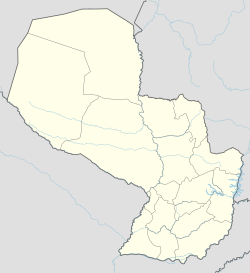Areguá
| Areguá | |||
|---|---|---|---|
| City | |||
 |
|||
|
|||
| Coordinates: 25°17′43″S 57°24′53″W / 25.29528°S 57.41472°WCoordinates: 25°17′43″S 57°24′53″W / 25.29528°S 57.41472°W | |||
| Country |
|
||
| Department | Central | ||
| Founded | 1538 | ||
| Government | |||
| • Intendente Municipal | Luis A. Meredes Villalba Jara | ||
| Area | |||
| • Total | 147,67 km2 (5,702 sq mi) | ||
| Elevation | 70 m (230 ft) | ||
| Population (2016) | |||
| • Total | 70,490 | ||
| • Density | 4.8/km2 (12/sq mi) | ||
| Time zone | AST (UTC-04) | ||
| • Summer (DST) | ADT (UTC-03) | ||
| Postal code | 2680 | ||
| Area code(s) | (595) (291) | ||
| Climate | Cfa | ||
Areguá (Spanish pronunciation: [aɾeˈɣwa]) is a city in Paraguay, located 28 km away from the capital city Asunción and it is the capital of the Department of Central. The city lies between a group of rolling hills with a distinctive rock formation (found only in 3 places in the world) and Ypacaraí lake and is known for its colonial architecture, along with its original cobblestone streets. It also goes by the name "City of Strawberries" because of the large production of strawberries here.
Areguá takes its name from its indigenous inhabitants, the Mbyá Guaraní, who originated from the area before Spanish colonization. This group was called Ariguá, which means "those from above," referring to the region's high altitude.
The climate in this town is warm. In the summer temperatures reach 40 °C, while in winter the temperatures average 0 °C. The rainiest period is between January and April. The pleasant climate makes Areguá popular with tourists, especially because of its ideal location on Ypacarai Lake.
Areguá has 67,847 inhabitants in total, of which 33,977 are males and 33,870 are females, according to the projections made by The General Direction of Statistics, Surveys and Census. (Projection 2008)
Originally, the town was named "Tapaichuá". It was founded by Domingo Martínez de Irala, in 1538, in the territory of Indian people who occupied land on the banks of the Ypacarai Lake. Its inhabitants lived in the area surrounding the present church of Areguá.
At the beginning of the Spanish colonisation, the town was a cattle-raising farm of Mercedarian origin. At the end of the 19th century, it was developed as a summer city where most of the writers, artists and intellectuals lived in the hot months.
Apart from being an important source of income in the region, this fruit has its own history. In fact, the production of this fruit is a particular characteristic of Areguá. According to local people, back to 1920, in The Estanzuela Settling, a farmer put all his strength in strawberry growing.
...
Wikipedia



